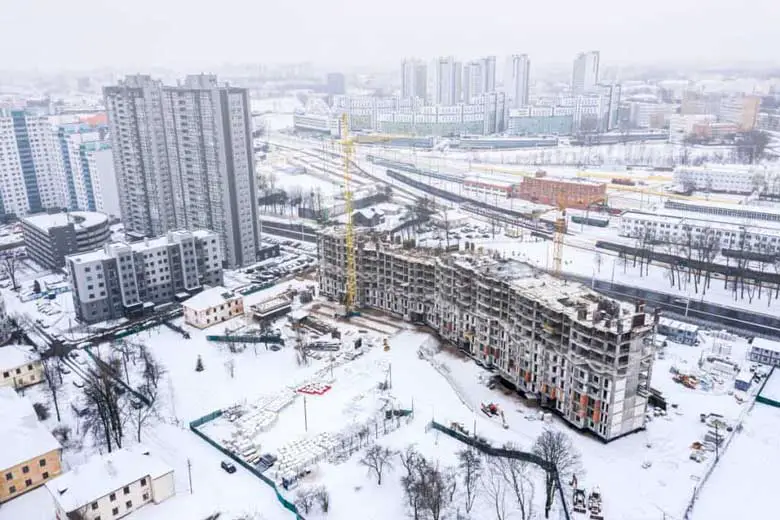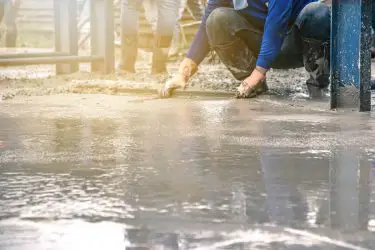You have probably noticed, with great relief, that there is much less construction activity in your city during the winter. In Chicago, we say that there are two seasons: construction and winter. It is common for construction crews to wait until warmer temperatures to pour concrete because cold weather conditions affect the progress of the work, especially the concrete pouring process.
Concrete can be poured in the winter if you follow a few rules. However, if the temperatures get below freezing, it can become a lot more complicated. You must avoid pouring concrete on frozen ground and ensure that it does not freeze within the first twenty-four hours.
The rest of this article will explore a few topics related to this question, including the science of concrete and how cold weather affects it, a few tips for pouring concrete in colder temperatures, and what you should avoid when pouring concrete in the winter.

Table of Contents
How Does Cold Weather Affect Concrete?
Concrete is susceptible to cold temperatures, thriving in ideal temperatures between 50 and 60 ℉ (10-15 ℃). Under these conditions, mixing the concrete powder with water transforms it from a thick liquid-type substance into the solid material that makes up our sidewalks.
This transformation occurs through a process called hydration, in which the water and concrete mixture goes through a chemical reaction, and it begins to crystalize.
The more crystals it forms, the stronger the concrete becomes. In warmer temperatures, concrete can reach its minimum strength (500 pounds or 226.8 kilograms per square inch) necessary in 24 hours.
However, colder temperatures slow this process down significantly and can even stop crystals from forming altogether.
Taking proper cold-weather precautions can make for an even stronger concrete because of the slower curing process.
Curing Process
Concrete must go through a curing process to transform from a liquid to a solid. This critical process requires the appropriate conditions and maintenance.
Failing to properly cure the concrete or not maintaining its ideal weather conditions can result in weak and overall shoddy quality work. The weakened state of concrete presents itself with many fine cracks and a dusty appearance.
Concrete curing’s primary purpose is to allow the concrete to lock in moisture for strength retention; it prevents cracking and shrinkage until the concrete is strong enough and makes the finished product more robust and durable for long-term use.
The entire process can take about one month, but the most critical time period after the concrete is initially poured is within the first 24 hours. The concrete must be kept warm enough for that period.
If concrete experiences a significant drop in temperature in that initial 24-hour window, you can expect that the concrete will lose over 50% of its strength and not regain it.
Cold Weather Concrete Tips
For concrete to set and crystalize properly, you have to create a warm enough environment, essentially fooling the concrete into thinking it’s warm.
This section will go over a few of the necessary precautions you must take before pouring concrete in the winter:
- Cover newly dug ground with insulated blankets. You need the ground to maintain a temperature of at least 50 ℉ (10 ℃) for three days before you can proceed with pouring concrete. When you dig below the frost line, the newly exposed soil has a natural warmth. You can preserve this warmth by immediately covering it with a warm, insulated blanket and leaving it there until right before you are ready to pour the concrete.
- Ensure you have a plan in place. During the colder months, it is essential to make sure everyone is on the same page about the project. You and your team should agree on strategies, assignments, materials, and equipment you will use ahead of time. Strategizing ahead of time will help avoid any unnecessary confusion and ensure the best possible success for the concrete outcome.
- Adjust concrete mixture as necessary. It can help increase the amount of cement to water ratio in the mix in colder temperatures.
- Properly prepare your materials, including your real-time thermometers, tents, heaters, and any other pieces of equipment you will need to ensure the proper curing process should.
- Keep the concrete warm until it is ready to be poured. You can do this by keeping the trucks lined up in warmer climates, which may not always be possible depending on the worksite. You can also mix the concrete on-site using hot water.
- Do your best to keep the temperatures around the area warmer. There are a lot of ways you can protect the site where you are pouring concrete. Wind breaking walls (approximately 6 feet in height) work well for keeping a steady temperature. They also prevent quick reductions in temperature due to the wind chill.
- Similarly, another option is to use a heated tent. Tents work well for small scale projects and keep the crew warm. You can typically rent them, but you can also use a makeshift tent using tarps or other materials you have on hand.
- Pay close attention to changes in temperature. Winter weather can be unpredictable in many parts of the country. If you anticipate pouring concrete, continuously track the weather conditions for the hours you expect to pour it and during the critical 24-hour window afterward.
What To Avoid When Pouring Concrete in the Winter
You can undoubtedly pour concrete successfully in the winter months, but there are a few mistakes you should be careful to avoid. In this section, we will go over a few errors to avoid that are sure to result in low-quality concrete.
Avoid Pouring Concrete on Frozen Ground, Snow, or Ice
This avoidable mistake is sure to set your newly poured concrete up for failure. The nature of frozen materials means that they will change shape as they begin to thaw out.
The same is true of frozen ground, which means your concrete will be laid on an unstable surface, causing cracks.
It will also cause uneven curing due to the temperature differences, which will cause the bottom half of the concrete to be less stable than the top, leading to cracks and low structural integrity of the concrete.
If you must pour concrete for time-sensitive reasons, you can use heaters to thaw out the ground beforehand.
Do Not Allow Concrete To Freeze
As I mentioned earlier, concrete completely stops developing crystals when it gets too cold.
Temperatures as low as 25 ℉ (-4 ℃) can cause fresh concrete to freeze, potentially ruining the structural integrity of all of your hard work.
Avoid Using Cold Tools
When you use cold tools while you are pouring concrete, it will reduce the temperature of the concrete, negating all of the work you put into maintaining a warm enough environment.
Avoid this mistake by keeping all essential tools at the same temperature as the pouring area instead of stored outside the tent or in crewmembers’ trucks.
Final Thoughts
While it is possible to pour concrete in the winter, there are a lot of precautions you must take for it to reach its maximum strength. While the construction schedule will inevitably involve many variables, it would be best to schedule it on the warmer winter days, if possible.
If you must proceed with pouring concrete in cold weather, follow the precautions above for the best chance of success on your construction project. Because of its sensitivity to cold weather, concrete must be carefully cured and maintained during the winter. Good luck!




